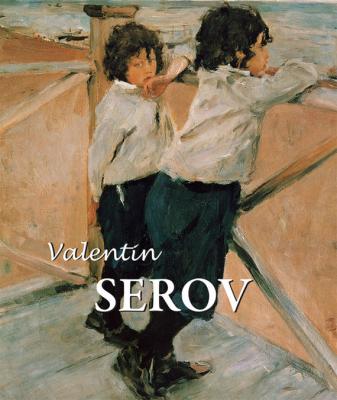ТОП просматриваемых книг сайта:
Valentin Serov. Dmitri V. Sarabianov
Читать онлайн.Название Valentin Serov
Год выпуска 2016
isbn 978-1-78310-024-8
Автор произведения Dmitri V. Sarabianov
Жанр Биографии и Мемуары
Серия Best of
Издательство Parkstone International Publishing
Catherine II Setting out to Hunt with Falcons, 1902.
Tempera and gouache on cardboard, 23 × 40 cm.
The State Russian Museum, St Petersburg.
Abraham’s Servant Finds Isaac a Bride, Rebekah, 1894.
Oil on panel, 23.5 × 33 cm.
The State Tretyakov Gallery, Moscow.
Portrait of Grand Duke Pavel Alexandrovich, 1897.
Oil on canvas, 166.7 × 149.5 cm.
The State Tretyakov Gallery, Moscow.
In Girl with Peaches, one actually senses a momentary stillness, a pregnant calm, after which the young creature will erupt into motion and transform the whole interior by mixing up the objects. Movement in the composition is stressed by a receding tabletop and a foreshortened figure. Serov offsets this movement with the pink triangle of the blouse and the free symmetry of the objects scattered around the room, seemingly at random but actually deliberately arranged.
A different motif is chosen for Sunlit Girl. The girl abides in a state of complete rest, with no intention of interrupting it. There is a stillness throughout, a repose, a fusion of the human being with the sun, the air, the environment. Whereas in Girl with Peaches the artist achieves the effect of balanced movement with the help of various compositional devices, here the opposite is true: he seeks to resolve the theme by harmoniously contrasting the motionless figure in the foreground against a backdrop that creates the impression of a spatial “breakthrough”. In both cases Serov transcends the “study”, and though he paints from nature he never loses sight of the finished picture existing in his mind’s eye. This is where he differs from his constant companion Korovin, and in this lies his potential for further change.
There is every indication in both cases of a penchant for Impressionism. Serov did not perceive the environment as a backdrop, as an accompaniment to the main theme. He was interested in every physical object that came into view and in every inch of the painted canvas. With Serov, the surface of each object reflects the light of adjacent objects and absorbs the rays of the sun. Everything is built on subtle transitions – the gradations of the colour values are almost imperceptible, the contours of the figures and objects begin to shift. Moreover, Serov discovers the beauty of colour as such: the tender pink of the girl’s blouse stands in magnificent contrast to the black bow; the deep blue of the skirt in Sunlit Girl does not seem subject to the influence of the sun and retains its integrity. Each pure colour, though, finds its “echo” in other parts of the canvas, sustaining the unity of the work.
Speaking of Serov’s Impressionism, we must bear in mind that it differs essentially from that of the French. To begin with, in the period in question Serov knew very little about the French Impressionists. The French artist he liked most, sharing this preference with many of his colleagues, was the extremely popular Jules Bastien-Lepage, whose manner was a far cry from true Impressionism. Nevertheless, the logic of Russian art’s evolution, its interest in plein air painting and the experience gained in the study of nature all conspired to lead Serov to Impressionist painting.
Summertime. Portrait of Olga Serova, 1895.
Oil on canvas, 73.5 × 93.8 cm.
The State Tretyakov Gallery, Moscow.
Sasha Serov, 1897.
Watercolour and white lead on paper, 42 × 58 cm.
Serov Collection, Moscow.
Portrait of Nikolai Andreyevich Rimsky-Korsakov, 1898.
Oil on canvas, 94 × 111 cm.
The State Tretyakov Gallery, Moscow.
The successes achieved by Repin, Polenov, and Surikov in their depictions of nature opened up new vistas before the younger artists. But for Serov’s Girls paintings, as for Korovin in Chorus Girl or Levitan in Birch Grove, it was not enough to emulate their elders. His was a resolute step toward a new system, a step that makes it possible to regard him, together with his contemporaries, as a founder of early Russian Impressionism, a method distinguished for its modesty, restraint, and a certain stylistic disparity. In Serov’s pictures, the painting of the human face was, as yet, substantially different from that of the landscape or interior. In Girl with Peaches, Vera Mamontova’s head is painted in smooth tenuous strokes, where the form and colour coincide completely, whereas in the blouse and the bow they do not. Serov often uses large areas of pure colour, particularly black, which the French Impressionists did their best to avoid. But perhaps the most distinctive feature of Serov’s art, compared to French Impressionism, is his unfeigned interest in the inner life of the model, an interest that continued to be the proud prerogative of Russian art in the 1870s and 1880s despite the new tasks it had to face.
Конец ознакомительного фрагмента.
Текст предоставлен ООО «ЛитРес».
Прочитайте эту книгу целиком, купив полную легальную версию на ЛитРес.
Безопасно оплатить книгу можно банковской картой Visa, MasterCard, Maestro, со счета мобильного телефона, с платежного терминала, в салоне МТС или Связной, через PayPal, WebMoney, Яндекс.Деньги, QIWI Кошелек, бонусными картами или другим удобным Вам способом.

